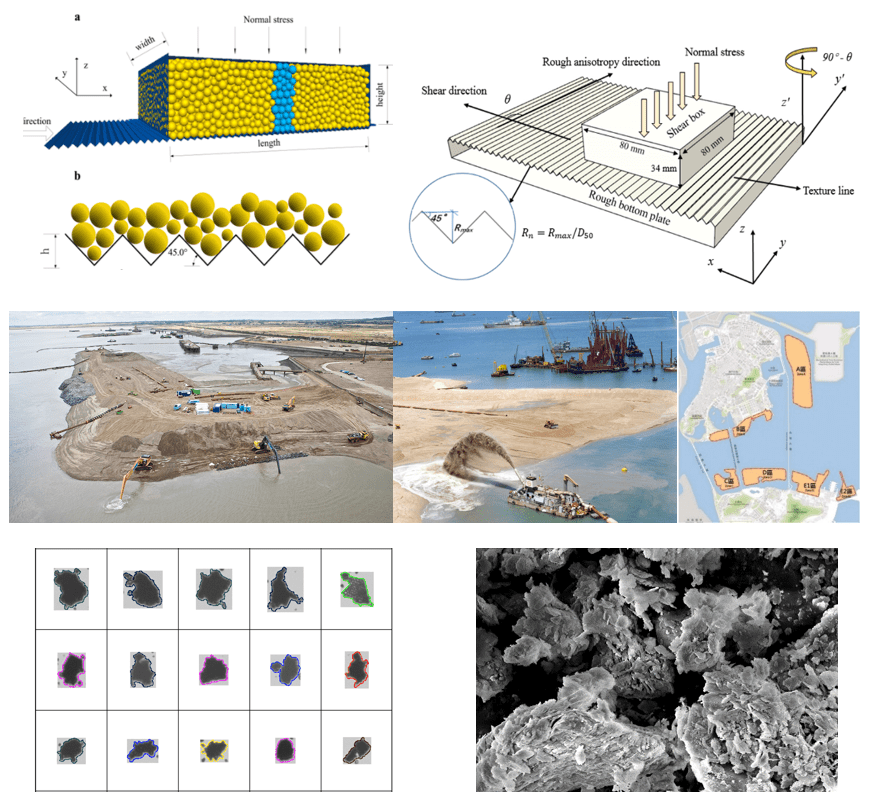
Mechanisms of soil-structure interface shear
Soil-structure interaction widely exists in geotechnical infrastructures, such as support for foundation, geosynthetics reinforced slope, anchor/rock bolt supported tunnel and pipelines. The shear behavior of soil-structure interface is essential for the security and quality control and the design. In this project, element interface shear tests and simulations of interface shear test using Discrete Element Method were performed. The effects of surface roughness, relative density, particle shape, initial fabric on the interface shear behavior were investigated from multiscale perspectives. The evolution of localized band during shearing was discussed and a scientific method was proposed to quantify the localized band thickness. Furthermore, the coorrelation between both coordinate number and fabric anisotropy with macroscopic shear behavior were discussed. Ref: ACTA GEOTECH 2018, INT J NUMER ANAL METHODS GEOMECH 2018, INT J GEOMECH. 2019.
Engineering characteristics of contaminated marine soft soil treated by advanced nanomaterials
Under the background of integration of the world economy and the strategy of Guangdong-Hong Kong-Macao Greater Bay Area, the marine economy and ocean resources are widely developed in Macau. While marine environmental problems which human activities due to have become increasingly considerable. Marine soil could become a sink for pollutants in aquatic and offshore ecosystems. With continuous pour of land-based pollution into the ocean, it would lead to the continuous spread of marine pollution and the reduction of ocean self-purification capacity. The nanoscale zero-valent iron (nZVI), an advanced nanomaterial with excellent treated performance, is regarded as available remediation options for groundwater treatment, contaminated soil treatment, and immobilization-stabilization in near ten years. This research issue combined geotechnical engineering and materials science to conduct the study on the remediation efficiency of nZVI usage on heavy metal-contaminated marine soft soil. It is found that nZVI treatment of contaminated marine soil not only has excellent treated efficiency, but also can significantly reinforce the mechanical properties of the soil, and proves that the nano-material has good engineering practice prospect in soft soil treatment under complex contamination conditions. Ref: ENG GEOL 2019, CAN GEOTECH J 2019, SCI TOTAL ENVIRON 2019.
Model selection for marine soft soil with creep behaviour
Long-term settlement due to creep of marine soft soil will lead to the decline of the city’s capacity of flood control, the damage of infrastructures and buildings. Large settlement may also cause rupture of pipelines, ground subsidence and thus building collapse. In the complex physico-chemo-biological environment, the deformation characteristics of different types of soils can be different. For engineers or researchers, it is hard to select a suitable model to analyze the creep behavior of a specific type of soil. The study therefore proposes an effectient method for identifying the most suitable models for different types of soft soils and their associated parameters as well as analyzes the uncertainty of the prediction based on the given data. It has been applied to the prediction of the long-term deformation of marine mud and pile foundation in deep sea in Hong Kong. Ref: COMPUT GEOTECH 2018, INT J NUMER ANAL METHODS GEOMECH 2018, OCEAN ENG 2018.
The laboratory is equiped with advanced geotechnical apparatuses for testing the geotechnical behaviours of various types of soil. They are: High-performance server, multi-mode field environment monitoring sensors (Decagon), fiber grating sensing system (Micron Optics), fully automatic consolidation apparatus (VJ tech), modified soil-structure interface shear apparatus (VJ tech), fully automatic stress path–seepage controlled triaxial apparatus (Geocomp), dynamic triaxial appararus (CKC), dual chamber unsaturated soil triaxial apparatus (VJ tech-DCTS).
Related publications:
- Chen, Y. Z., Zhou, W. H., Liu, F. M., & Yi, S. (2018). Exploring the Effects of Nanoscale Zero-valent Iron (nZVI) on the Mechanical Properties of Lead-contaminated Clay. Canadian Geotechnical Journal (IF=2.437), 56(10), 1395-1405.
- Chen, Y. Z., Zhou, W. H., Liu, F., Yi, S., & Geng, X. (2019). Microstructure and morphological characterization of lead-contaminated clay with nanoscale zero-valent iron (nZVI) treatment. Engineering Geology (IF=3.909), 256, 84-92.
- Jing, X.Y., Zhou, W. H., Zhu, H. X., Yin, Z. Y., & Li, Y. (2018). Analysis of soil‐structural interface behavior using three‐dimensional DEM simulations. International Journal for Numerical and Analytical Methods in Geomechanics (IF=2.481), 42(2), 339-357.
- Tan, F., Zhou, W.H., & Yuen, K.V. (2018). Effect of loading duration on uncertainty in creep analysis of clay. International Journal for Numerical and Analytical Methods in Geomechanics (IF=2.481), 42(11), 1235-1254.
- Zhou, W. H., Tan, F., & Yuen, K. V. (2018). Model updating and uncertainty analysis for creep behavior of soft soil. Computers and Geotechnics (IF=3.345), 100, 135-143.
- Zhou, W. H., Liu, F., Yi, S., Chen, Y. Z., Geng, X., & Zheng, C. (2019). Simultaneous stabilization of Pb and improvement of soil strength using nZVI. Science of The Total Environment (IF=5.589), 651, 877-884.
- Zhu, H., Zhou, W.H., & Yin, Z.Y. (2018). Deformation mechanism of strain localization in 2D numerical interface tests. Acta Geotechnica (IF=3.247), 13(3), 557-573.
